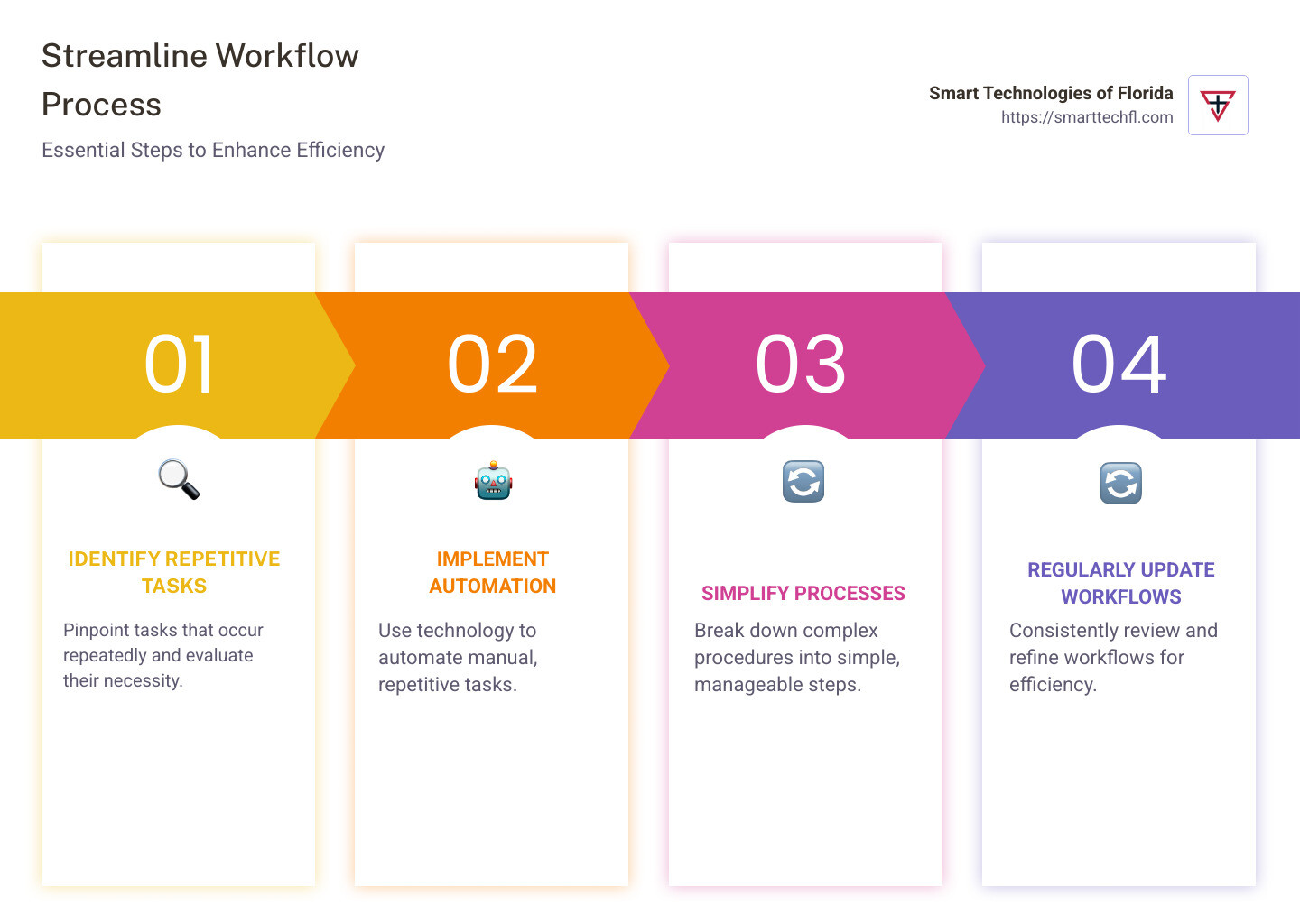Streamline Your Workflow: Tips for a Smoother Business Operation
Streamlining workflow processes is essential for any business wanting to thrive in today’s environment. By refining operations, businesses can boost workflow efficiency, reduce costs, and drive meaningful changes that support growth and innovation.
To streamline workflow process, focus on these key strategies:
- Identify repetitive tasks and eliminate them.
- Implement automation where possible.
- Simplify complex processes.
- Regularly review and update workflows.
Incorporating these methods can lead to vast improvements in productivity, reduce errors, and create a more dynamic working environment. Not only does streamlining help cut operational costs, but it also empowers staff by freeing them from tedious tasks, enabling them to focus on strategic initiatives and customer engagement.
This change is particularly vital for mid-sized retail businesses aiming for digital change without losing sight of the human element in their operations. By embracing smart technologies, companies can modernize while ensuring that their teams are empowered, not replaced.

Understanding Workflow Streamlining
Let’s break down what it means to streamline workflow processes. Think of it as cleaning out a cluttered garage. You want to get rid of what’s unnecessary, organize what you need, and make everything easy to find and use. In business, this means simplifying tasks, eliminating redundancies, and improving overall efficiency.
Simplifying Tasks
Simplification is about making tasks easier to complete. It’s like turning a complicated recipe into a simple one with fewer steps. In a business setting, this might mean using a project management tool to keep everyone on the same page. Tools like these provide a single source of truth, reducing the time spent coordinating and allowing teams to focus more on creating impactful work.
Example: A marketing team might use a tool to streamline their campaigns, ensuring everyone knows their roles and deadlines. This helps cut down on redundant tasks and improves communication.
Eliminating Redundancies
Redundancies are tasks or steps that are repeated unnecessarily. They can slow down processes and lead to frustration. By eliminating these redundancies, businesses can operate more smoothly.
Case Study: The grocery store chain Piggly Wiggly revolutionized shopping by letting customers pick their own items instead of relying on staff. This simple change eliminated unnecessary steps and streamlined the shopping process.
Improving Efficiency
Efficiency is doing more with less. It’s about maximizing output while minimizing input. By improving efficiency, businesses can save time and resources.
Fact: According to a Zapier report, 34% of companies say automation allows them to spend less time on administrative tasks, freeing up time for more strategic work.

In conclusion, by focusing on simplifying tasks, eliminating redundancies, and improving efficiency, businesses can create a more agile and productive environment. This approach not only improves performance but also empowers employees to focus on what truly matters.
Now, let’s explore the key steps to streamline workflow processes and how they can transform your business operations.
Streamline Workflow Process: Key Steps
Streamlining your workflow process is like tuning up a car engine. You want it running smoothly without any hiccups. Here are the key steps to achieve a streamlined workflow process: automation, process mapping, and goal setting.
Automation
Automation is your best friend when it comes to cutting down repetitive tasks. Think of it as having a robot assistant that handles the boring stuff. By automating tasks like data entry, you free up time for your team to focus on more important work.
Stat:
Automation not only speeds up processes but also reduces human errors. For example, using rule-based workflow processing, like automatically routing invoices for approval, ensures tasks are completed consistently and accurately.
Process Mapping
Before you automate, you need to map out your processes. This is like drawing a treasure map to see where you can find hidden efficiencies. Visualize the steps involved in your workflow and identify any bottlenecks or unnecessary steps.
Tip: Use flowcharts to map out each step. This helps you see where improvements can be made.
Process mapping helps you understand the current state of your workflow and highlights areas ripe for improvement. By clearly laying out each step, you can pinpoint where automation can have the most impact.
Goal Setting
Setting clear goals is crucial for a successful workflow. It’s like setting a destination before starting a journey. Define what you want to achieve with your streamlined process. Whether it’s reducing processing time or improving customer satisfaction, having clear goals guides your efforts.
Example: If your goal is to improve customer service response time, you might automate ticket routing to ensure faster handling.
Goals provide direction and help measure the success of your streamlining efforts. They ensure everyone is aligned and working towards the same objectives.
In summary, by focusing on automation, process mapping, and goal setting, you can transform your business operations into a well-oiled machine. These steps not only improve efficiency but also empower your team to focus on strategic tasks that drive growth.
Next, we’ll dive into the benefits you can reap from streamlining workflows.
Benefits of Streamlining Workflows
Streamlining workflows is more than just making things run faster. It’s about creating a system that reduces errors, boosts productivity, and ensures compliance. Let’s break down these benefits:
Reduce Errors
When tasks are manual, mistakes happen. A missed decimal point or an overlooked email can lead to costly errors. By streamlining workflows through automation and standardized processes, you significantly cut down on human errors.
Fact: Rule-based workflow processing minimizes mistakes by ensuring tasks are completed correctly every time. This is crucial for businesses that rely on accuracy, like finance and healthcare.
Improve Productivity
A streamlined workflow means your team spends less time on repetitive tasks and more time on work that matters. Automation tools, like those that handle data entry or customer orders, free up valuable time.
Stat: Automated workflows empower employees to focus on strategic, high-value tasks, leading to increased productivity. This shift allows your team to be more innovative and responsive to business needs.
Ensure Compliance
In industries where regulations are strict, compliance is non-negotiable. Streamlined workflows help ensure that every step is documented and followed precisely. With automated systems, you can easily track and verify compliance, reducing the risk of costly fines.
Quote: “By digitizing and automating processes, you not only ensure compliance but also increase digital security and eliminate data silos,” highlights the importance of a streamlined approach.
By reducing errors, improving productivity, and ensuring compliance, streamlined workflows transform your business operations. They create a more efficient, reliable, and agile organization ready to meet the challenges of today’s world.
Next, we’ll explore the tools and techniques that can help you achieve these benefits.
Tools and Techniques for Streamlining
To streamline workflow processes, you need the right tools and techniques. Let’s explore some key elements that can make your business operations smoother and more efficient.
Automation Software
Automation software is a game-changer for businesses. It takes over repetitive tasks, allowing your team to focus on more important work. For example, using automation tools for data entry or customer order processing can save time and reduce errors.
Example: Imagine your accounts team spending hours every month on manual billing. With automation software, this process can be completed in minutes, freeing up time for strategic tasks.
Templates
Templates are another powerful tool. They provide a standardized format for recurring tasks, ensuring consistency and efficiency. Whether it’s a project plan or a marketing campaign, templates help streamline workflows by eliminating the need to start from scratch every time.
Tip: Use templates to standardize documents like invoices, reports, and emails. This not only saves time but also ensures that all communications are professional and on-brand.
Integration
Integration is about connecting different systems and tools so they work together seamlessly. When your software applications are integrated, data flows smoothly between them, eliminating the need for manual data entry and reducing the risk of errors.
Case Study: A company integrated its CRM with its email marketing platform. This allowed customer data to automatically update across systems, improving communication and targeting efforts.
By leveraging automation software, templates, and integration, you can significantly improve your workflow efficiency. These tools and techniques not only save time but also improve accuracy and collaboration across your organization.
Next, we’ll answer some frequently asked questions about streamlining workflows.
Frequently Asked Questions about Streamlining Workflows
What does it mean to streamline workflow?
Streamlining a workflow means making a process simpler and more efficient. It involves identifying and eliminating unnecessary tasks that slow down operations. By focusing on the essential steps, businesses can reduce complexity and improve productivity.
For instance, if a workflow involves multiple approvals that don’t add value, consider removing some of them. This cuts down on time and resources, making the process smoother.
How can automation help in streamlining?
Automation plays a crucial role in streamlining workflows by reducing manual work and increasing efficiency. When repetitive tasks, like data entry or email sorting, are automated, employees have more time for strategic activities that drive business growth.
Consider this: a company automates its customer service responses for common queries. This not only speeds up response time but also allows support staff to focus on more complex customer issues, improving overall service quality.
What are the signs that a workflow needs streamlining?
Recognizing the signs of an inefficient workflow is the first step toward improvement. Here are some indicators:
- Bottlenecks: If tasks are constantly delayed due to waiting for approvals or resources, it’s a sign of a bottleneck.
- Repetitive Tasks: Performing the same tasks repeatedly without variation suggests there’s room for automation.
- Increased Completion Time: If the time to complete a process is growing, it’s likely due to unnecessary steps or outdated methods.
By addressing these issues, businesses can streamline workflow processes, ensuring operations run smoothly and efficiently.
Next, we’ll wrap up with some concluding thoughts on how Smart Technologies of Florida can help your business make strategic, people-centric changes.
Conclusion
At Smart Technologies of Florida, we believe that strategic change is not just about adopting new technologies. It’s about creating a people-centric approach that aligns with your unique business goals.
With over 23 years of experience, we’ve learned that every organization is different. That’s why we tailor our digital solutions to fit your specific needs, ensuring that the change journey is smooth and effective. Our focus on empowering businesses through strategic change and innovation means we don’t just implement changes—we help you accept them.
Streamlining workflow processes is a critical part of this change. By simplifying tasks, eliminating redundancies, and leveraging automation, we help businesses reduce errors, improve productivity, and improve compliance. Our approach ensures that your team can focus on what truly matters: driving growth and achieving your business objectives.
If you’re ready to take the next step in streamlining your workflows and open uping new levels of efficiency, visit our Business Process Automation page to learn more about how we can assist you in this journey.
Strategic change is not just about technology—it’s about people. At Smart Technologies of Florida, we are committed to guiding you through this change with a focus on your team and your goals. Let’s work together to create a smarter, more efficient future for your business.












